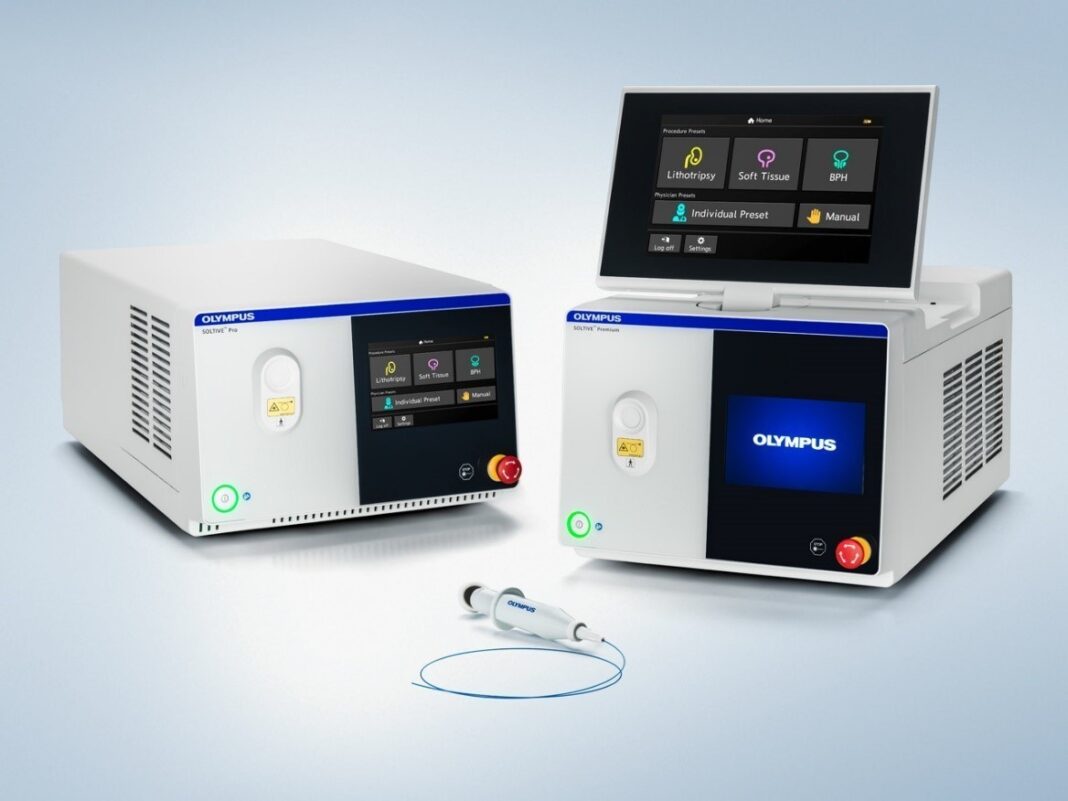Olympus today announced abstract findings of independent clinical studies that show the treatment of kidney stones with the SOLTIVE™ Premium SuperPulsed Laser System (more) (SOLTIVE Laser System) may offer the potential for shorter procedure times, better patient outcomes and lower procedures costs than those performed with Holmium: YAG.
The two abstracts noting these findings were published in the September edition of The Journal of Urology. They compared performing ureteroscopy and laser lithotripsy with Holmium: YAG versus Thulium Fiber Laser (TFL) and treatment of kidney stones in the upper urinary tract using Holmium: YAG versus TFL in dusting mode.
Launched in 2020, the SOLTIVE Laser System offers a new application of thulium fiber laser technology designed for stone lithotripsy, benign prostatic hyperplasia and other soft tissue applications. The SOLTIVE Laser’s primary benefit is next-generation lithotripsy performance, dusting stones in half the time it takes the advanced post-modulation Holmium: YAG technology, creating a fine dust that is more easily passed through urine.1
As with non-laser surgery, the possibility of complications and adverse events, such as chills, fever, edema, hemorrhage, inflammation, tissue necrosis, or infection may occur following treatment. In extreme cases, death may occur due to procedural complications, concurrent illness, or laser application. As with any conventional surgery, acute pain may occur immediately following laser therapy and may persist for as long as 48 hours.
In the first abstract from the University of Maine Medical Center in Portland, Maine, physicians treated 51 patients each with Holmium: YAG and TFL.2 The operative time, measured from scope in to scope out, was on average nearly 13 minutes shorter per procedure with TFL compared to Holmium: YAG. Further analysis showed that cases with a cumulative stone diameter less than 15mm resulted in a procedure difference of nearly 14 minutes and the mean difference was more than 17 minutes for cases with a stone of less than 10mm.
The study concluded that TFL is a “substantially faster means of laser lithotripsy” than Holmium: YAG with average procedure time reduced by 20%.
“As the number of URS laser lithotripsy procedures being performed in the United States continues to increase, reducing procedure times has the potential to improve patient outcomes and decrease costs,” according to the study.
The second abstract from the University of Rochester Medical Center in Rochester, N.Y., compared the efficiency and cost effectiveness of the SOLTIVE Laser System versus Holmium: YAG operating in the fixed dusting setting.3 The abstract included 62 patients divided evenly between the two procedures. There were no significant differences among the patients or kidney stones that measured between 10 and 30mm.
The abstract showed that procedures to remove kidney stones in the upper urinary tract performed with SOLTIVE were on average 2.6 minutes shorter than with Holmium: YAG. Procedures for kidney stones measuring less than 15mm were 3.4 minutes shorter and procedures with stones larger than 15mm were nearly 2 minutes shorter.
Researchers estimate a projected savings of $69 per procedure utilizing SOLTIVE, which was also superior in terms of stone-free rate, retropulsion, visibility and controlling bleeding, according to the study.
“Preliminary clinical data demonstrated the effectiveness of TLF in dusting kidney stones compared to 100W Ho:YAG laser (EMPOWER) at fixed laser settings,” said Dr. Ahmed Ghazi, one of the researchers and an associate professor of urology at the University of Rochester Medical Center. “This new data based on patient procedures demonstrates the efficiency and cost effectiveness of TFL.”
The efficiency of the SOLTIVE Laser System’s laser fibers in breaking apart the stones is due to absorption in water. Its compact footprint is one-eighth of the size of other Holmium: YAG systems and runs more efficiently, requiring only a standard 110-volt power outlet.
“When Olympus launched the SOLTIVE Laser System, we were excited to offer an innovative laser technology that would provide urologists a tool to improve efficiencies and patient outcomes,” said Patrick MacCarthy, Vice President of the Urology Business Unit for Olympus Corporation. “Now, we’re excited to see the results of independent studies that show how SOLTIVE is lowering the times and costs of kidney stone procedures.”



